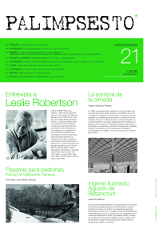The “architecture” of COVID-19
DOI:
https://doi.org/10.5821/palimpsesto.21.9494Keywords:
health architecture, covid-19, emergency, planification, innovation.Abstract
The COVID-19 pandemic, which affects a large part of the world, promotes reflection in all areas. Architecture and Planning are undoubtedly among them. The public health emergency placed a strong pressure on the healthcare system and infrastructures. Hospitals responded well due to the effort and creativity of the healthcare professionals. Healthcare personnel is the only resource that cannot be manufactured or built.
The reuse of buildings and the addition of new facilities of all kinds was used to support and provide more space to hospitals. Some media use the term “architecture” to define these actions. During critical situations, it is essential to activate emergency solutions for survival. However, these solutions do not meet any of the qualities of today’s healthcare architecture, neither for patients nor for those who work there. These solutions are, as Nikolaus Pevsner would say, “bicycle sheds”.
The emergency must be the exception. We must work to improve our ability to respond in critical situations and use these experiences to advance, even faster, in the current lines of research of the healthcare architecture. The COVID-19 “architecture” is not here to stay. You cannot even have a building for every disease. That is something of past centuries. Architecture, including healthcare architecture, is part of a country’s culture. It must be preserved and, in times like these, it should not be forgotten when building health facilities.
Downloads
Published
Issue
Section
License
PROTECTION AND INTELLECTUAL PROPERTY CRITERIA
Authors whose work is published in en Palimpsesto agree to the following terms:
1. The author retains the copyrights and guarantees the magazine the right to apply a Creative Commons Attribution-NonCommercial-NoDerivatives (CC BY-NC-ND), which permits others to share the work with acknowledgement of authorship.
2. The author may establish additional agreements of his or her own accord for non-exclusive distribution of the article published in the magazine (for example, in an institutional repository, or published in a book).
3. Electronic distribution of the work by the author(s) is permitted and encouraged (for example, in institutional repositories or on the author’s own website), prior to, and during the submission process, as this can generate productive exchanges, as well as earlier and greater citation of the published works (see The Effect of Open Access) (in English).
4. The author or provider of the material submitted for publication authorizes Palimpsesto to publish, with no obligation whatsoever (financial or otherwise) to the content of said material, be it in paper or digital format, or in any other medium.
5. The author or provider guarantees that he or she is the owner of the Intellectual Property rights to the contents provided, which encompasses the text and images/photographs/photographic works incorporated in the article.
6. The author or provider, exempts Palimpsesto magazine of all and any responsibility relating to violation of copyrights, thereby committing himself or herself to undertaking all efforts to assist Palimpsesto magazine in defence of any accusation, extra-judiciary, and/or judicial measures. Likewise, the author or provider will assume payment to Palimpsesto of any sum or compensation that must be paid to third parties for failure to comply with these obligations, be it the result of judicial, arbitrary or administrative decisions.
7. The submission of the texts by authors implies automatically a declaration of non plagiarism of its contents







